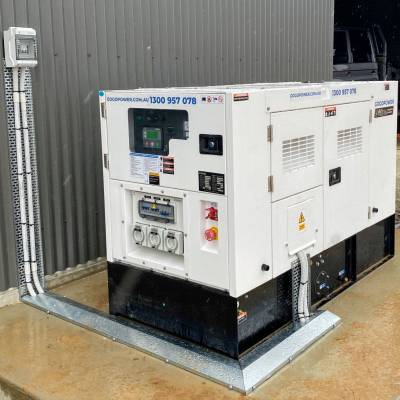

Learn more about off-grid solar power systems, their main components, system design considerations, and our design and quote process.
Off-Grid solar and battery systems – also known as Stand-alone power systems (SAPS or SPS) are available in various types and sizes, ranging from small portable kits or pre-wired plug & play systems, to medium-sized systems for sheds, weekenders, cottages, and large capacity systems for off-grid homes and rural businesses.
The smallest – most basic setups are often DC only systems that don’t include an inverter for AC supply. These systems usually have a 12V battery bank and are designed to power 12V lighting and appliances such as DC fridges, DC pumps, laptops and phone chargers.
12V DC systems will have a relatively low power delivery & energy storage capacity. A small portable plug-in inverter can be used to operate low power 240V AC equipment occasionally if required.
As the power and storage capacity of a system increases, the battery bank voltage will also be increased up to 24V for small systems or 48V for medium and above. They will also incorporate an integrated inverter to supply AC power for appliances. The power rating of the inverter will increase as the system capacity increases.

What are the components of an off-grid / stand-alone power system?
(Solar Array)
Because the panels in an off-grid power system are the primary — and often only — power source, you need modules that deliver maximum reliability and high performance in all conditions. For this reason, we recommend using REC Alpha Pure-R high-performance solar panels.
REC’s Alpha Pure-R panels offer:
(typically 12V, 24V, or 48V)
An off-grid system will include one or more of the following components, depending on system type & configuration:

(Genset)
Provides back-up power supply, can be either:
Monitoring can be local only or include remote access. Components include status display screens, internet connection & communication devices, control & management interfaces.
The method used for mounting the solar panel array will depend on the specific situation and application.
The three main types of solar panel mounting are:
The mounting frames and rails should have engineering certification, and be installed according to the manufacturer’s instruction manual & the relevant Australian standards.
The balance of system (BOS) refers to the components of a PV system other than the panels and other main components including:
Although these are lesser components, the use of inferior quality materials can lead to system failures. Therefore, high-quality balance of system components must be used to ensure overall system performance and reliability. This is especially important in off-grid situations, as system downtime could mean loss of power supply for an extended period.


The first and most important step when designing an off-grid power system is to assess your energy requirements. Knowing how much power the system will need to supply is necessary to determine the required size for the solar panel array and battery bank, and also to decide which inverters and chargers will be most suitable.
When it comes to off-grid solar power systems there is no one size fits all approach, and there is certainly no room for guesswork when it comes to off-grid system planning. Correct system sizing by an experienced designer is crucial to having an efficient & reliable off-grid power supply.
We also need to ensure the battery bank has enough capacity for periods of bad weather, and the solar panel array can generate enough energy to cover consumption even during the months with the lowest solar production conditions.
Our design will also take other factors into consideration including:

Environmental
– Site-specific irradiance levels (peak sun hours)
– Maximum and minimum temperatures
– Shading
– Snow / Dust
– Battery location (Temperature controlled room?)
Electrical
– Continuous load demand
– Surge demand (peak power demand)
– Time of energy usage (energy profile)
– Load power factor
– Maximum charge & discharge rates
– Required battery autonomy
System
– System inefficiencies (inherent and site-specific)
– De-rating factors
– Panel mounting/location
– Panel orientation & tilt
– System installation location
What are the steps involved in getting an off-grid power system design & quote?
The process can be summarised into 6 stages as follows.
As mentioned in the previous section, this is the most important step in the process.
Because each aspect of system design that follows will depend on this information, it is worth spending the time to complete this step as thoroughly as possible.
Preliminary system size and price range can be advised after a few questions about the purpose of the system and the main power-consuming appliances that it will supply power to.
i.e. Is the system for a farm shed? Irrigation pumps? family home? summer weekender? stockyard lights & power?
Proceeding further will involve a deeper look into the site specifics and energy requirements.
There are a few ways to do this and a common method is to fill out a load assessment sheet with appliance power consumption and estimated run times. From this, we can determine the daily kWh energy requirement.
Additionally, we’ll gather information about some other aspects that can affect design options.
For example:
• major appliances
– air conditioning, hot water, cooking, large pumps, workshop equipment (welders/air compressors/hoists)
• seasonal or year-round use, occasional or full-time use
• effect of seasonal variations – eg; winter heating, summer irrigation, summer AC
• time of consumption – day/night
• your choices & preferences
• battery autonomy – 2 days, 3 days? (affects the size of the battery bank)
• backup generator options
• upsizing solar array or battery bank capacity
• future considerations – for example; plans to increase capacity or add wind/hydro in future
The next stage will be to produce the system design – with assistance from our specialised system design software. This will be carried out by our qualified, accredited, and experienced off-grid design team.
Once we have completed the design stage, we’ll present to you a comprehensive system proposal that includes energy production and consumption estimates, solar potential & yield estimates, financial simulations (ROI, system lifetime savings, etc), system component info & specs.
At this time we’ll consult with you to discuss your option preferences and any budget considerations.
Upon your acceptance of the system proposal, we will finalise the design for the chosen system and options.
A job order will be created and we’ll send details for a deposit payment to get things underway.
Our technicians will build your system in our workshop, program the configuration settings, and run it through a testing procedure. Once testing has been completed, we’ll get the system ready for deployment to the site, or pack it for delivery in the case of Plug and Play/DIY kits.
The final step will be to coordinate with you to schedule installation.
Your system will then be installed and commissioned by our technicians.
Monitoring & communications access will be set up and we’ll provide you with a system introduction and briefing on operation and maintenance, along with a comprehensive system owner’s manual.

The cost of an off-grid system will depend on a number of factors, the main ones being:
For an indication of what you could expect to pay for an off-grid system, here are 3 broad categories based on system size with price range.
1.5kWh - 5kWh/day
Water pumps
Electric gates
Stockyard lighting
Security cameras
Perimeter lighting
5kWh - 12kWh/day
Weekender
Small workshop
Cabin/Cottage
Site office
Shed
12kWh - 24kWh/day
Off-grid home
Large workshop
Small business

Tired of rising electricity bills and unreliable grids? Imagine a future powered by the sun, free from grid dependence and hefty connection costs. This comprehensive guide, brought to you by SolarWise Wagga, unlocks the secrets of off-grid solar living.
Inside, you’ll discover:


When choosing SolarWise Wagga, you can feel confident that you will have a professionally designed system that meets your present and future energy requirements, is well suited to your property, and will provide a great return on your investment.





